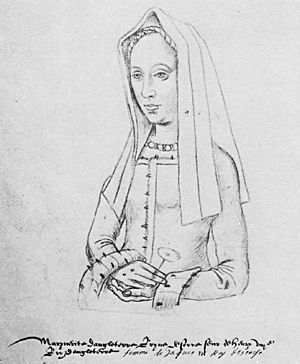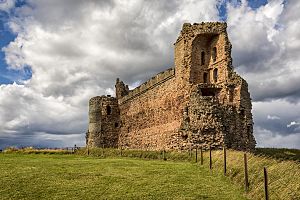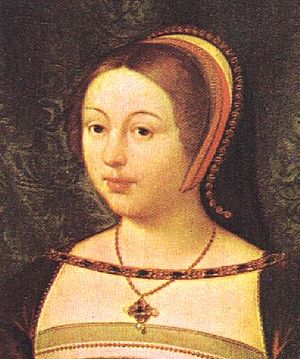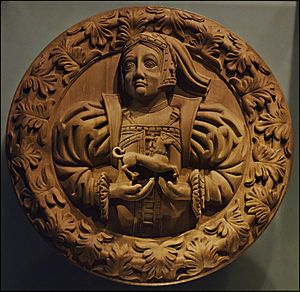Jewels of Margaret Tudor facts for kids

Margaret Tudor was an English princess, daughter of King Henry VII and Elizabeth of York. In 1503, she married King James IV of Scotland. Her beautiful jewels and clothes were a big part of her royal life, and many records tell us about them.
Contents
Becoming Queen of Scots
When Margaret traveled to Scotland to marry King James IV, her journey was very grand. An English official, John Young, described her amazing jewels and clothes. For example, when she went to church at York Cathedral, she wore a dress made of "cloth of gold." This fabric was woven with real gold threads! She also had a necklace of precious stones and a fancy gold belt that reached the floor.
People kept detailed records of her clothes and even the beds sent with her to Scotland. These beds had her family symbols sewn onto them. In 1503, a Scottish goldsmith named John Currour made a special crown for Margaret. He melted down gold coins to create it and was paid for his work.
At the Scottish court, it was a tradition to exchange gifts on New Year's Day. In January 1504, King James IV gave Margaret a heavy gold coin and two rings with beautiful blue sapphires. Margaret also gave gifts, and one of her ladies-in-waiting, Eleanor Verney, received a gold chain. Later that month, the goldsmith John Currour fixed two collars decorated with swans and added pearls to two crosses that James gave to Margaret.
Jewels Left at Tantallon Castle

In September 1515, Margaret Tudor left Linlithgow Palace and headed back to England. On her way, she left a chest full of jewels at Tantallon Castle. A Scottish knight, Alexander Jardine, was put in charge of keeping them safe. Margaret later wrote from England, asking for her jewels to be sent to her.
There are two lists of these jewels, both written in the old Scots Language. The second list was part of a letter sent to Margaret by the Scottish Lords of Council on September 29, 1516.
At the time, there were some dramatic stories about Margaret leaving Scotland. One story, heard by the Venetian ambassador in London, said that the Duke of Albany had trapped her at Stirling Castle and she had to escape. This story was not entirely true. The Duke of Albany did send letters to her as she traveled south towards England. A writer from the 1500s, John Lesley, said that Margaret gave Stirling Castle to Albany but then started to disagree with him. Fearing his anger, she "quietly fled from Tantallon to Berwick in England" on August 12.
Jewels for Hats and Headwear
The jewels Margaret left at Tantallon included special bands for the front of her hoods or head dresses. These were called "shaffrons" or "chaffrouns." These jewels were often set onto velvet fabric. Scottish records show that a "chaffron" could also be the name of the velvet strip itself for a hood. Another type of chaffron was made of gold wire.
Jewels were also set on fabric edgings called "burdes," which were used to decorate hoods or other parts of her clothes. In English records, similar "borders" could be for the neckline of a gown or for sleeves.
A Spanish ambassador, Pedro de Ayala, wrote in 1498 that Scottish women "dress much better than here (in England), especially their head-dresses, which are, I think, the handsomest in the world." It's not clear if Margaret's "chaffrons" were very different from jeweled bands worn in other countries.
Margaret also had hats with jewels called "hingers" or "targets." A "tergat" was a jewel worn on a hood. She also owned partlets, which were pieces of clothing worn at the shoulders, decorated with gold fringes and pearls. There was even a small box with spools of gold wire, perhaps for styling her hair or for embroidery. The jewels from Tantallon were sent to Margaret in London in two separate deliveries.
Lists of the Jewels
The first group of jewels sent back to Margaret in England included:
- A chaffron (headband) with a gold edging and 81 pearls.
- A chaffron with a white enamel gold chain.
- A chaffron with pearl sets.
- A chaffron with goldsmith's work and 35 pearls.
- A chaffron with gold leaves, 7 rubies, and 18 pearls.
- A new gold chain with 40 links and 5 knots.
- A pair of sleeves made of gold wire.
- A ruff (ruffled collar) made of taffeta.
- A partlet (shoulder covering) of black velvet with goldsmith's work and 30 pearls.
- A partlet of gold damask fabric.
The second delivery of jewels included:
- A black velvet chaffron with a chain of 57 or 58 links.
- A chaffron with gold points and 61 pearls on crimson velvet.
- A chaffron set with gold, 21 rubies, and 33 pearls.
- A gold border or edging and two small belts with gold heads and pendants.
- A gold collar weighing 6 ounces.
- A piece of a chain belonging to the Laird of Bass, with 10 links.
- A pair of sleeves of cloth of gold lined with crimson satin.
- Another pair of sleeves of cloth of gold (unlined).
- The King of France's large diamond, set on a red silk hat.
- A black hat with a "hinger" (jewel) of a ruby and three pearls.
- Various pieces of yellow satin, white taffeta, and tawny satin.
- A red velvet lining for gown sleeves.
- A packet with sealed letters.
- A gold collar, decorated with white and red roses, weighing 6 ounces.
- Four pillowcases.
- Five silk hats (without "hingars" or badges).
- A partlet of crimson satin with a gold pattern, 12 diamonds, 14 rubies, and 25 pearls.
- Another partlet of cloth of gold.
- A white taffeta partlet with three large pearls.
- A taffeta partlet with goldsmith's work.
- A pair of black velvet sleeves.
- A box of gold damask with ten spools of gold wire, ribbons, and sewing silk.
This delivery also included religious items:
- A rosary of coral beads with 6 larger pearl beads.
- A rosary of jasper beads with four larger beads.
- A pair of black beads and a pair of white beads.
- Margaret's will (her testament).
- Two silver boxes with holy wax.
- An embroidered hood.
- Four pieces of crisp or crêpe fabric.
- A pomander (a ball of scented materials) with silver.
- A crystal stone.
- A box made of bone or ivory.
- Four books.
- A gold "target" (badge) with an image of Our Lady, weighing 7 crowns.
Some jewels were collected by an agent of Thomas Dacre. A Scottish messenger, Ross Herald, brought jewels to Margaret in London in 1517.
Jewels in James V's Collection
Margaret Tudor passed away at Methven Castle in October 1541. Some of her jewels might have been included in the lists of her son, King James V. He ordered his servants to pack up her belongings at Methven for his own use.
In 1542, in the Jewel House at Edinburgh Castle, there was a rosary of jasper beads with gold larger beads. There was also an ornament for a woman's chest with 21 sets of pearls, with three pearls in each set. The king's servant, Henry Kemp, kept some of the king's jewels, including a "tablet with an image of our Lady" and two "hingers." One was a diamond "M" with a hanging pearl, and the other was a ruby "H" with images. These might have been connected to Margaret Tudor.
Susannah and the Elders Portrait
An interesting painting of Margaret Tudor with two other people, known as the Bute portrait, is displayed at the National Galleries of Scotland. In this painting, Margaret wears a medallion on her belt that shows a scene from the Bible story of Susannah and the Elders.
Margaret's daughter, Margaret Douglas, also received some special jewels. When she married the Earl of Lennox in 1544, Princess Mary gave her a red ruby with a flat-cut diamond and three smaller hanging pearls. She also received a gold brooch with a large sapphire, a gold brooch with a ruby and the "History of Susanne" (meaning a picture or scene from the story of Susannah), and a gold brooch with the "History of David" (from the Bible).
|
See also



